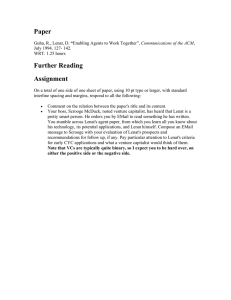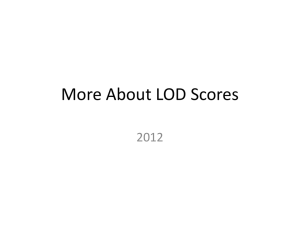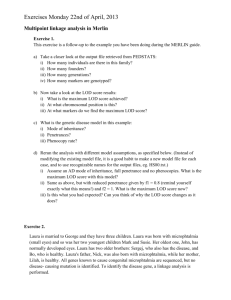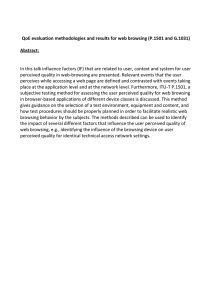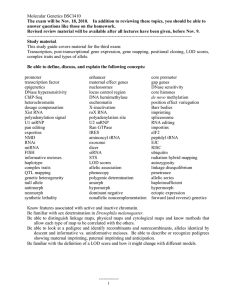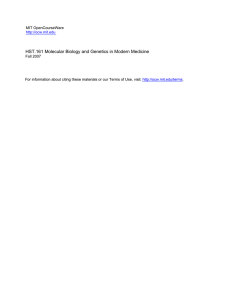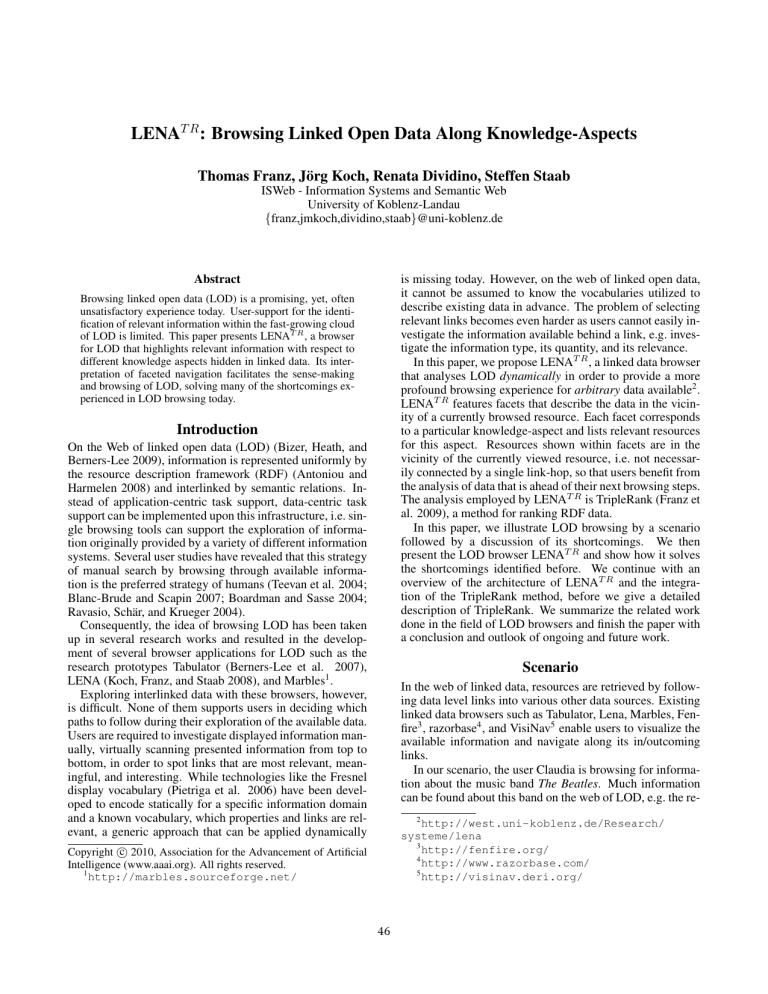
LENAT R : Browsing Linked Open Data Along Knowledge-Aspects
Thomas Franz, Jörg Koch, Renata Dividino, Steffen Staab
ISWeb - Information Systems and Semantic Web
University of Koblenz-Landau
{franz,jmkoch,dividino,staab}@uni-koblenz.de
is missing today. However, on the web of linked open data,
it cannot be assumed to know the vocabularies utilized to
describe existing data in advance. The problem of selecting
relevant links becomes even harder as users cannot easily investigate the information available behind a link, e.g. investigate the information type, its quantity, and its relevance.
In this paper, we propose LENAT R , a linked data browser
that analyses LOD dynamically in order to provide a more
profound browsing experience for arbitrary data available2 .
LENAT R features facets that describe the data in the vicinity of a currently browsed resource. Each facet corresponds
to a particular knowledge-aspect and lists relevant resources
for this aspect. Resources shown within facets are in the
vicinity of the currently viewed resource, i.e. not necessarily connected by a single link-hop, so that users benefit from
the analysis of data that is ahead of their next browsing steps.
The analysis employed by LENAT R is TripleRank (Franz et
al. 2009), a method for ranking RDF data.
In this paper, we illustrate LOD browsing by a scenario
followed by a discussion of its shortcomings. We then
present the LOD browser LENAT R and show how it solves
the shortcomings identified before. We continue with an
overview of the architecture of LENAT R and the integration of the TripleRank method, before we give a detailed
description of TripleRank. We summarize the related work
done in the field of LOD browsers and finish the paper with
a conclusion and outlook of ongoing and future work.
Abstract
Browsing linked open data (LOD) is a promising, yet, often
unsatisfactory experience today. User-support for the identification of relevant information within the fast-growing cloud
of LOD is limited. This paper presents LENAT R , a browser
for LOD that highlights relevant information with respect to
different knowledge aspects hidden in linked data. Its interpretation of faceted navigation facilitates the sense-making
and browsing of LOD, solving many of the shortcomings experienced in LOD browsing today.
Introduction
On the Web of linked open data (LOD) (Bizer, Heath, and
Berners-Lee 2009), information is represented uniformly by
the resource description framework (RDF) (Antoniou and
Harmelen 2008) and interlinked by semantic relations. Instead of application-centric task support, data-centric task
support can be implemented upon this infrastructure, i.e. single browsing tools can support the exploration of information originally provided by a variety of different information
systems. Several user studies have revealed that this strategy
of manual search by browsing through available information is the preferred strategy of humans (Teevan et al. 2004;
Blanc-Brude and Scapin 2007; Boardman and Sasse 2004;
Ravasio, Schär, and Krueger 2004).
Consequently, the idea of browsing LOD has been taken
up in several research works and resulted in the development of several browser applications for LOD such as the
research prototypes Tabulator (Berners-Lee et al. 2007),
LENA (Koch, Franz, and Staab 2008), and Marbles1 .
Exploring interlinked data with these browsers, however,
is difficult. None of them supports users in deciding which
paths to follow during their exploration of the available data.
Users are required to investigate displayed information manually, virtually scanning presented information from top to
bottom, in order to spot links that are most relevant, meaningful, and interesting. While technologies like the Fresnel
display vocabulary (Pietriga et al. 2006) have been developed to encode statically for a specific information domain
and a known vocabulary, which properties and links are relevant, a generic approach that can be applied dynamically
Scenario
In the web of linked data, resources are retrieved by following data level links into various other data sources. Existing
linked data browsers such as Tabulator, Lena, Marbles, Fenfire3 , razorbase4 , and VisiNav5 enable users to visualize the
available information and navigate along its in/outcoming
links.
In our scenario, the user Claudia is browsing for information about the music band The Beatles. Much information
can be found about this band on the web of LOD, e.g. the re2
http://west.uni-koblenz.de/Research/
systeme/lena
3
http://fenfire.org/
4
http://www.razorbase.com/
5
http://visinav.deri.org/
c 2010, Association for the Advancement of Artificial
Copyright Intelligence (www.aaai.org). All rights reserved.
1
http://marbles.sourceforge.net/
46
Figure 1: Browsing DBPedia: Which properties and which information is relevant here? The figure shows screenshots of
the Marbles browser on the left, the Zitgist browser in the center, and the Openlink browser on the right, rendering a lot of
information corresponding to The Beatles resource.
complex for users. The magnitude of information available
today, i.e. at the advent of LOD, makes the identification and
quantification of relevant links difficult.
Furthermore, LOD browsing is realized by following data
links corresponding to a one-step-at-a-time approach. The
user is able to select one available resource at a time; from
there he goes on to the next navigation step. This approach,
however, limits exploring the sophisticated interrelations of
the web of LOD.
At last, even though the linked data principles are being
adopted by an increasing number of data providers over the
last years, the portion of links across data sets is often low,
i.e. the available information is poor linked or inadequate.
In such cases, the user is not able to explore a qualitative
number of links and consequently he does not learn much
more about the information he was seeking by browsing than
he would when using other retrieval methods.
Back to our scenario, Claudia is seeking for information
about the band The Beatles because she would like to buy
one of the band’s albums. For Claudia it is important that
the album has many songs that she has already heard. Since
Claudia usually cannot remember a song’s name, she learns
about the band and albums by reading their discography, by
knowing its members, music style, and so on.
Due to the huge amount of information (e.g. the resource
source http://dbpedia.org/resource/The_Beatles
is linked to music labels that have published albums of the
band, it lists people whom they have worked with, countries
they have visited, the birthday of each of the band members,
birth town and so on.
Figure 1 shows how data about the music band is presented by different LOD browsers. The resource title is
displayed at the top associated with corresponding property
names and property values. A property value again describes
either a dereferenceable resource or a literal. The user can
select these property value resources in order to visualize
the associated data. For instance, if Claudia would like to
get more information about the current members of the band
the Beatles, she looks up the property currentMembers and
follows one of the links associated to its resource property
values.
Shortcomings
Browsing data is about adopting an exploratory search approach over a dataspace. Usually, the user is trying to find
some information which could not be formulated as a precise query or be completely retrieved by a search engine. By
browsing available information, the user learns about and investigates the dataspace by navigating along in/outcoming
links. Exploratory search in LOD, however, can be very
47
tions of facets enable users to investigate on the knowledgeaspect expressed by a facet.
The facets themselves are ordered according to their relevance with respect to the resource currently viewed in
LENAT R . The relevance of a facet is expressed by the
weight that is displayed below the name of each facet, e.g.
Figure 2 highlights the weight of the facet currentMembers.
Each facet lists several resources. The list is ordered so
that the most relevant resources are at the top of the list. This
ordering is based on scores that can also be investigated by
users. The tooltip for resources of a facet shows the complete URI of the resource and its score. Figure 2 shows such
a tooltip for the resource Paul McCartney that is the top resource for the facet currentMembers.
The facets provided by LENAT R build upon rankings for
resources and properties in the vicinity of the resource currently displayed by LENAT R . These rankings are computed
at runtime whenever a new resource is browsed. As ranking method, we integrated the TripleRank approach. Its outputs are exploited by the user interface features presented.
To highlight how these features of LENAT R help to overcome the shortcomings in LOD browsing identified above,
we confront LENAT R with each shortcoming in the following.
The Beatles is associated with more than 1000 others resources) Claudia cannot identify which of the links could
help her to be more effective for getting the overview of the
band.
Additionally, Claudia is irritated by the fact that there
exist ambiguous and redundant links in the data. For instance, three properties end with label in the description of
the band. As Claudia finds out, the properties ending with
label have very different meanings. Some are used to label
the resource The Beatles with a string, others link to music
labels, i.e. publishers of songs by The Beatles. Claudia has
spotted several of such similar ending properties, e.g. dbpedia.org/ontology/writer and dbpedia.org/property/writer.
However, unlike for properties ending with label, the links
ending with writer seem to have identical meanings as they
all seem to link to people who have written songs of The
Beatles.
Furthermore, Claudia experiences links leading to statements with few further outcoming links, such as http://
www.w3.org/2002/07/owl#Class, or even to dead ends,
thus stopping further navigation and requiring her to go back
and forth several times. The following list enumerates the
shortcomings experienced by Claudia:
1. The magnitude of information makes the identification
and quantification of relevant links difficult.
Shortcoming 1: The magnitude of information makes
the identification and quantification of relevant links difficult. As illustrated in Figure 1, LOD browsing can easily
lead to information overload. LENAT R implements faceted
navigation as a counter measure to information overload.
Facets assist users in browsing LOD by guiding them along
most promising knowledge aspects, giving them a means
to explore the correlations between resources and available
LOD. They enable to identify relevant resources and properties more easily than by scanning manually through all of the
available information and thus mitigate the negative effect of
feeling overloaded.
2. The one-step browsing approach implemented by current
browsers limits the exploration of the sophisticated interrelations in the web of linked data.
3. Redundant and ambiguous links reduce the effectiveness
and efficiency of browsing.
4. Dead-ends in LOD interrupt the browsing process as they
require users to browse backwards manually in order to
find further relevant information.
These shortcomings of browsing LOD are related to the fact
that none of the current LOD browsers provide sophisticated
functionalities to support and guide users to explore interrelations in the web of LOD, such as, to present a list of
relevant resources for a resource, which are not necessarily
connected by a single link-hop, or to present the relevant
resources organized by different aspects.
Shortcoming 2: The one-step approach limits exploring
the sophisticated interrelations of the web of data. By
combining LOD browsing and faceted navigation, a user
is not just able to browse LOD along RDF links based on
the one-step navigation approach but also to browse along
facets. This combination enables users to go beyond explicit
links by exploring along facets. As explained before, a facet
corresponds to a set of similar types of links and thus represents an implicit link. Moreover, resources shown within the
facets offered by LENAT R are not necessarily connected by
a single link-hop. They are suggested based on the TripleRank analysis that considers resources in the vicinity of the resource currently viewed. Accordingly, selecting a resource
of a facet in LENAT R can correspond to multiple browsing
steps.
LENAT R
LENAT R is a linked data browser that features faceted navigation (cf. Fig. 2) to overcome the shortcomings listed in the
section above. A facet is a named group of resources where
resources of a group have a similar – not necessarily exactly
the same – relation to the resource currently displayed by
LENAT R . For instance, Figure 2 shows the facets label,
associatedActs, currentMembers and so on for the resource
The Beatles.
By moving the mouse over the name of a facet, the predicates contributing to a facet are shown as tooltip. Figure 2
shows such a tooltip for the facet associatedActs. It lists the
complete URIs of the contributing properties and the score
used for ranking them. In this example the top-three predicates are associatedActs, associatedBand, associatedMusicalArtist, all with a score of more than 0.4. These descrip-
Shortcoming 3: Redundant and ambiguous links. The
scenario has revealed the existence of ambiguous and redundant links as a cause for dissatisfaction and irritation. Facets
provided by LENAT R summarize multiple types of links,
e.g. as shown by Figure 2. They also provide a simple means
to distinguish among groups of links. Thus, they effectively
48
! ! !
! Figure 2: Screenshot of LENAT R . Relevances of facets, facet properties, and facet resources are marked by yellow rectangles.
hide redundancy and ambiguity of the underlying data and
thus mitigate irritations caused by it.
Shortcoming 4: Dead-ends in LOD interrupt the browsing process. The web of LOD connects well defined
datasets to a huge cloud of interlinked data. However, many
resources have only few outgoing links and can be considered as dead ends that interrupt the browsing process. By
faceted LOD browsing as implemented by LENAT R , users
are always enabled to navigate to resources that are not directly connected by a single-link-hop. Consequently, the
browsing process does not end because no links can be followed anymore.
Architecture
TR
Figure 3: Architecture of LENAT R .
LENA
runs as Java servlet application accessible from
common web browsers. It utilizes an implementation of the
TripleRank method (Franz et al. 2009) in order to support
LOD faceted browsing. In the following, we describe the
work-process of LENAT R and review its architecture (see
Fig. 3).
LENAT R implements the Model-View-Controller (MVC)
pattern. The controller manages incoming requests from the
browser, queries data from the model, and serves the view
with data for the final rendering output. The model allows
for requesting LOD, e.g. by means of SPARQL queries. It
serves a triple cache of local repositories to reduce network
overhead. The view consists of XHTML templates used to
generate the final rendering output with help of the provided
controller information. Since LENAT R relies on the Fresnel display vocabulary for rendering requested datasets, the
controller utilizes the JFresnel Java library in order to apply
Fresnel (Pietriga et al. 2006) definitions.
49
PARAFAC Analysis
Upon incoming HTTP requests from web browsers, the
requested RDF resource is rendered according to the standard LENA rendering process (Koch, Franz, and Staab
2008). In parallel, the TripleRank components are invoked
and requested by means of an AJAX call. Thus, the user can
immediately inspect the resource, while assisting facets are
provided as soon as the TripleRank processing is complete.
The three TripleRank components (crawler, pre-processor,
analyser) are processed consecutively, whereas the resulting
facets are injected into the user interface by means of AJAX.
As analysis step, a decomposition of the tensor is performed
to detect hidden dependencies in the data. The TripleRank
implementation applies the PARAFAC method for this purpose. It is regarded as a higher-order equivalent to a matrix
decomposition like the singular value decomposition (SVD).
The PARAFAC tensor decomposition has the advantage of
robustness and computational efficiency. These advantages
are due to its uniqueness property with respect to the scaling
and permutation of produced component matrices (Harshman and Lundy 1994). The analysis step transforms the input tensor into a Kruskal tensor that corresponds to authority
and hub scores (Kleinberg 1999) for particular latent aspects
(topics) of the analyzed data.
Formally, a tensor T ∈ Rk×l×m is decomposed by nRank-PARAFAC into component matrices U1 ∈ Rk×n ,
U2 ∈ Rl×n , U3 ∈ Rm×n and n principal factors (pf )
λi in descending order.Via these, T can be written as a
n
Kruskal tensor by T≈ k=1 λk · U1k ◦ U2k ◦ U3k where λk
denotes the kth principal factor, Uik the kth column of Ui
and ◦ the outer product (Kolda and Bader 2009). Ui yields
the ratio of the ith dimension to the principal factors. So,
similar to SVD, PARAFAC derives hidden dependencies related to the principal factors and expresses the dimensions
of the tensor by relations to the principal factors. Depending on the number of principal factors, the PARAFAC decomposition can be loss-free. For a third-mode-tensor T
∈ Rk×l×m a weak upper bound for this rank is known:
rank(T) ≤ min{kl, lm, km} (Kolda and Bader 2009).
While there is no proper way for estimating the optimal
number of principal factors for an appropriate decomposition, several indicators like residue analysis and core consistency analysis exist for its estimation (Andersson and Bro
2000).
The output of a PARAFAC decomposition can be interpreted as authority and hub scores plus additional scores for
the relevance of link types, i.e. RDF properties. Table 4(c)
shows the scores of RDF properties and authority scores for
resources. At the time of this writing, hub scores are not
utilized by LENAT R .
TripleRank
The TripleRank implementation is separated into three core
components; namely, the crawler, pre-processor and analysis component (cf. Fig. 3). The crawler component performs a breadth-first search. It emanates from the requested
resource and recursively aggregates related LOD up to a certain depth, link-, and statement limit. Technically, RDF data
is requested from LOD data providers on the semantic web
via SPARQL endpoints. The output of the crawling-process
is a RDF graph (e.g. as shown by Figure 4(a)), which is
transformed into a tensor representation (cf. Figure 4(b)),
that is input for the pre-processor.
The pre-processor component is responsible for i) reducing the amount of the crawled data and for ii) increasing
its quality. E.g. properties linking a majority of resources
are discarded, since they only marginally contribute to the
overall information. Secondly, statements are strengthened
according to their property frequency, whereas less frequent
properties are weighted stronger, since their significance appears to be more eminent (for details see (Franz et al. 2009)).
The TripleRank analysis computes a list of weighted
facets for a given RDF graph. Each facet is described by
multiple weighted RDF properties that contribute to it. As
illustrated by Figure 2, the user interface of LENAT R enables to view the contributing properties and their ranking scores. Additionally, TripleRank also returns for each
facet, a ranked list of RDF resources that are displayed
by LENAT R to ease the browsing experience as discussed
above. Table 4(c) illustrates the results produced by TripleRank for the RDF graph shown in Figure 4(a).
Related Work
A few research works also deal with the challenge of facilitating users with more effective, efficient, and satisfying
browsing support for linked open data. The Fresnel framework (Pietriga et al. 2006) consists of a vocabulary to express how certain information shall be presented, what the
ordering for displayed information is and which information
to leave out. Interpreters are provided that select, filter, and
present data according to such specifications. While this approach requires to encode statically how information is displayed, with LENAT R we persue an approach to identify the
best links and resources dynamically.
Unlike LENAT R , Parallax (Huynh and Karger 2009) is a
browser for RDF data that enables users to formulate join
conditions and type restrictions in an intuitive manner that
does not require users to be acquainted with a query language. The Tabulator browser (Berners-Lee et al. 2007)
Tensor Model
By means of the crawler and pre-processing components, an
RDF graph is created that is transformed to a tensor representation. Figure 4(b) illustrates the tensor representation resulting from the transformation of the sample graph
shown in Fig. 4(a). The first adjacency matrix T (:, :, 1)6
models linkage by the property loves. An entry > 0 corresponds to the existence of a link by this property, empty
entries are considered as zeroes. The second matrix T
(:, :, 2) models links by the property hates. For instance,
the graph expresses that Alex hates Bob, which corresponds
to T (1, 2, 2) = 1.
6
Throughout this paper we use the common Matlab-notation for
addressing entries in tensors and vectors
50
Score
1.00
1.00
0.001
(a) Input: RDF Graph
(b) Transformation: Tensor
Representation
Property Score
Facet 1
hates
0.71
0.70
Facet 2
loves
0.70
hates
0.70
0.10
Resource
Bob
Chris
Don
Alex
Elly
(c) Analysis: Results from PARAFAC
Figure 4: Illustration of the TripleRank Process
References
also implements support for the formulation of queries on
LOD. Queries are triggered on available LOD by selecting
predicates and thereby creating a query pattern. The results
of those queries can be visualized with respect to different
information aspects, e.g. a map view that indicates spatial
relations. Sig.ma (Tummarello et al. 2009) is a search engine for the Semantic Web that offers versatile utilizations
of search results including their selection and filtering (e.g.
by data source), export to several formats, and different display options. Unlike LENAT R , sig.ma does not provide a
ranking for the data retrieved. The Marbles browser also implements a means to ease the exploration and sense-making
of LOD by indicating the provenance of resources. The
metaphor of marbles is employed to distinguish between different sources of information. The Openlink Dataexplorer7
supports the filtering and ordering of information. Furthermore, various domain-specific views are provided, e.g. for
data described by the FOAF vocabulary.
Andersson, C. A., and Bro, R. 2000. The n-way toolbox for matlab. Chemometrics and Intelligent Laboratory Systems 52(1):1 –
4.
Antoniou, G., and Harmelen, F. v. 2008. A Semantic Web Primer,
2nd Edition (Cooperative Information Systems). The MIT Press.
Berners-Lee, T.; Hollenbach, J.; Lu, K.; Presbrey, J.;
Prud’hommeaux, E.; and Schraefel, M. 2007. Tabulator redux:
Writing into the semantic web. Technical report.
Bizer, C.; Heath, T.; and Berners-Lee, T. 2009. Linked data
- the story so far. International Journal on Semantic Web and
Information Systems.
Blanc-Brude, T., and Scapin, D. L. 2007. What do people recall
about their documents?: implications for desktop search tools. In
Intelligent User Interfaces, 102–111.
Boardman, R., and Sasse, M. A. 2004. ”stuff goes into the computer and doesn’t come out”: a cross-tool study of personal information management. In CHI, 583–590.
Franz, T.; Schultz, A.; Sizov, S.; and Staab, S. 2009. Triplerank:
Ranking semantic web data by tensor decomposition. In International Semantic Web Conference.
Harshman, R. A., and Lundy, M. E. 1994. Parafac: Parallel factor
analysis. Computational Statistics & Data Analysis 18(1):39–72.
Huynh, D., and Karger, D. 2009. Parallax and companion: Setbased browsing for the data web. In WWW Conference.
Kleinberg, J. M. 1999. Authoritative sources in a hyperlinked
environment. J. ACM 46(5):604–632.
Koch, J.; Franz, T.; and Staab, S. 2008. Lena - browsing rdf data
more complex than foaf. In International Semantic Web Conference, Demo Session.
Kolda, T. G., and Bader, B. W. 2009. Tensor decompositions and
applications. SIAM Review 51(3).
Pietriga, E.; Bizer, C.; Karger, D.; and Lee, R. 2006. Fresnel: A
browser-independent presentation vocabulary for rdf. In International Semantic Web Conference, 158–171.
Ravasio, P.; Schär, S. G.; and Krueger, H. 2004. In pursuit of desktop evolution: User problems and practices with
modern desktop systems. ACM Trans. Comput.-Hum. Interact.
11(2):156–180.
Teevan, J.; Alvarado, C.; Ackerman, M. S.; and Karger, D. R.
2004. The perfect search engine is not enough: a study of orienteering behavior in directed search. In CHI, 415–422.
Tummarello, G.; Cyganiak, R.; Catasta, M.; Danielczyk, S.; and
Decker, S. 2009. Sig.ma. In Semantic Web Challenge at ISWC.
Conclusion and Outlook
This paper has presented a faceted navigation approach that
integrates a novel ranking method with linked data principles. Its implementation by LENAT R enables users to
browse along hidden and diverse knowledge aspects and has
been addressed in several ways: First, a user interface for
faceted navigation has been presented. Second, the exploitation of a novel method for relevance ranking of linked open
data, namely TripleRank has been illustrated. Third, the integration of this method into an architecture that facilitates
the user interface has been described.
We are currently investigating on several optimizations of
the components of LENAT R , focussing particularly on the
components for crawling and caching the LOD used for the
analysis by TripleRank. We also aim for an extensive evaluation that considers implicit feedback gathered by users of
LENAT R .
Acknowledgements This research was supported by the
European Commission under contract IST-FP6-026978, XMedia. The expressed content is the view of the authors but
not necessarily the view of the X-Media project.
7
http://demo.openlinksw.com/ode/
51

